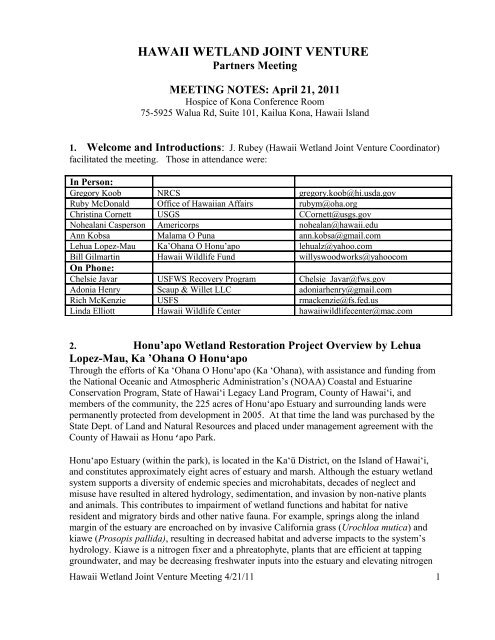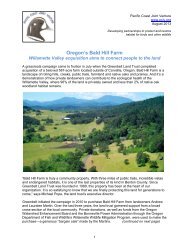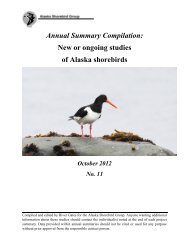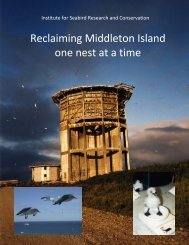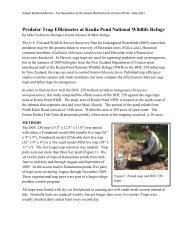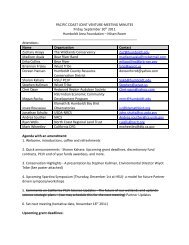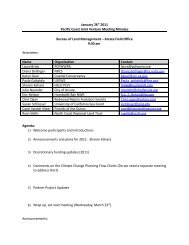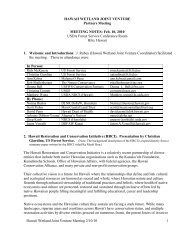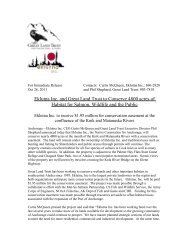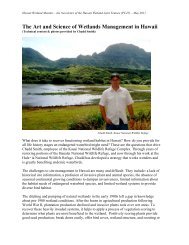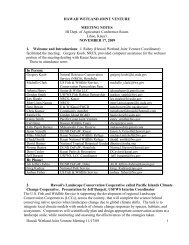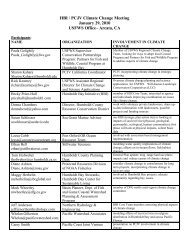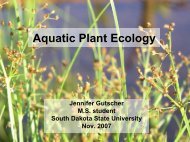hawaii wetland joint venture - Pacific Coast Joint Venture
hawaii wetland joint venture - Pacific Coast Joint Venture
hawaii wetland joint venture - Pacific Coast Joint Venture
You also want an ePaper? Increase the reach of your titles
YUMPU automatically turns print PDFs into web optimized ePapers that Google loves.
HAWAII WETLAND JOINT VENTURE<br />
Partners Meeting<br />
MEETING NOTES: April 21, 2011<br />
Hospice of Kona Conference Room<br />
75-5925 Walua Rd, Suite 101, Kailua Kona, Hawaii Island<br />
1. Welcome and Introductions: J. Rubey (Hawaii Wetland <strong>Joint</strong> <strong>Venture</strong> Coordinator)<br />
facilitated the meeting. Those in attendance were:<br />
In Person:<br />
Gregory Koob NRCS gregory.koob@hi.usda.gov<br />
Ruby McDonald Office of Hawaiian Affairs rubym@oha.org<br />
Christina Cornett USGS CCornett@usgs.gov<br />
Nohealani Casperson Americorps nohealan@<strong>hawaii</strong>.edu<br />
Ann Kobsa Malama O Puna ann.kobsa@gmail.com<br />
Lehua Lopez-Mau Ka’Ohana O Honu’apo lehualz@yahoo.com<br />
Bill Gilmartin Hawaii Wildlife Fund willyswoodworks@yahoocom<br />
On Phone:<br />
Chelsie Javar USFWS Recovery Program Chelsie_Javar@fws.gov<br />
Adonia Henry Scaup & Willet LLC adoniarhenry@gmail.com<br />
Rich McKenzie USFS rmackenzie@fs.fed.us<br />
Linda Elliott Hawaii Wildlife Center <strong>hawaii</strong>wildlifecenter@mac.com<br />
2. Honu’apo Wetland Restoration Project Overview by Lehua<br />
Lopez-Mau, Ka ’Ohana O Honuʻapo<br />
Through the efforts of Ka ‘Ohana O Honu‘apo (Ka ‘Ohana), with assistance and funding from<br />
the National Oceanic and Atmospheric Administration’s (NOAA) <strong>Coast</strong>al and Estuarine<br />
Conservation Program, State of Hawai‘i Legacy Land Program, County of Hawai‘i, and<br />
members of the community, the 225 acres of Honu‘apo Estuary and surrounding lands were<br />
permanently protected from development in 2005. At that time the land was purchased by the<br />
State Dept. of Land and Natural Resources and placed under management agreement with the<br />
County of Hawaii as Honuʻapo Park.<br />
Honu‘apo Estuary (within the park), is located in the Ka‘ū District, on the Island of Hawai‘i,<br />
and constitutes approximately eight acres of estuary and marsh. Although the estuary <strong>wetland</strong><br />
system supports a diversity of endemic species and microhabitats, decades of neglect and<br />
misuse have resulted in altered hydrology, sedimentation, and invasion by non-native plants<br />
and animals. This contributes to impairment of <strong>wetland</strong> functions and habitat for native<br />
resident and migratory birds and other native fauna. For example, springs along the inland<br />
margin of the estuary are encroached on by invasive California grass (Urochloa mutica) and<br />
kiawe (Prosopis pallida), resulting in decreased habitat and adverse impacts to the system’s<br />
hydrology. Kiawe is a nitrogen fixer and a phreatophyte, plants that are efficient at tapping<br />
groundwater, and may be decreasing freshwater inputs into the estuary and elevating nitrogen<br />
Hawaii Wetland <strong>Joint</strong> <strong>Venture</strong> Meeting 4/21/11 1
levels. Previous studies of the estuary and surrounding area indicate that native species,<br />
including birds listed as endangered or species of concern, are present in the area. Although the<br />
system shows signs of degradation, management actions can be employed to help enhance<br />
habitat for native flora and fauna and to restore sections that have been filled or irreversibly<br />
altered. Enhancement and restoration actions are expected to increase habitat and improve<br />
<strong>wetland</strong> function.<br />
A Wetland Habitat Restoration Plan for Honu‘apo Estuary (WHRP), prepared by Sustainable<br />
Resources Group International Inc., is nearing completion and will provide guidance for a<br />
<strong>wetland</strong> restoration project that will restore the aquatic functions of the estuary through<br />
removal of invasive non-native plants; excavation of fill and contouring the topography to<br />
enhance physical habitat; planting native and endemic plants; and controlling predation on<br />
avian species. These actions are expected to improve habitat for native waterbirds, fish, and<br />
turtles and enhance other <strong>wetland</strong> functions. The WHRP is part of a Resource Management<br />
Plan that has been developed/adopted for Honu‘apo Park that provides land use guidance to<br />
help protect and restore the important natural and cultural resources of the property while<br />
providing integrated and respectful recreation and education opportunities for the Ka‘ū<br />
community and visitors.<br />
Ka ‘Ohana’s mission is to restore, care for, and protect the cultural and natural resources within<br />
the Honu‘apo area, working in partnership with Hawaii County Division of Parks and<br />
Recreation. The area containing Honu‘apo Park has played an integral role in Ka‘ū’s<br />
community life for many generations. Historically the area was a fishing village called<br />
Honu‘apo Village. The large estuary at Honu‘apo was used as a fishpond. Freshwater springs<br />
discharging into the estuary provided water for the residents of the village. Part of this place<br />
was also said to have had a well-known pu‘uhonua, a place of refuge.<br />
Ka ‘Ohana secured funding from the State of Hawai‘i <strong>Coast</strong>al Zone Management (CZM)<br />
Program (through County of Hawai‘i Department of Planning), the U.S. Fish and Wildlife<br />
Service (USFWS), the <strong>Pacific</strong> <strong>Coast</strong> <strong>Joint</strong> <strong>Venture</strong> (PCJV), and private sources to develop the<br />
WHRP. The next steps will be to seek financial assistance to implement the <strong>wetland</strong><br />
restoration plan.<br />
3. HWJV Coordinator’s Update by J. Rubey<br />
NEW Wetlands Brochure. DOFAW’s new Wetland Brochure and Poster, funded by the PCJV,<br />
were passed out. It is the first <strong>wetland</strong>s information material available for the general public of<br />
Hawaii. The brochure and poster can be accessed on the PCJV website at:<br />
www.pcjv.org/<strong>hawaii</strong>/<strong>wetland</strong>s Copies of the poster can be obtained directly from DOFAW’s<br />
Michelle Jones at Michelle.G.Jones@<strong>hawaii</strong>.gov<br />
PCJV Board Meeting & Discretionary Fund Projects. The PCJV Board just met in early April for<br />
their regular semi-annual meeting. A topic of discussion was the federal budget delays and making<br />
decisions regarding the PCJV discretionary fund projects. Since funding levels are unknown, the<br />
Board decided to designate potential funding level thresholds where projects within these levels are<br />
Hawaii Wetland <strong>Joint</strong> <strong>Venture</strong> Meeting 4/21/11 2
tentatively approved. It was explained that Hawaii’s discretionary fund projects this year were<br />
determined by the HWJV Executive Steering Team based on the national evaluation performance<br />
matrix for <strong>Joint</strong> <strong>Venture</strong>s and the Team’s interest in improving the capacity of our HWJV.<br />
Therefore projects submitted this year build on the biological planning capacity of our JV.<br />
Funding Reminders: a) North American Wetland Conservation Act Standard Grant round in early<br />
March and early August. The small grants ($75K max.) proposals are annual and due the end of<br />
October. c) National <strong>Coast</strong>al Wetlands Grant proposals are due the end of June, with drafts in May.<br />
Contact Norma Creps, DOFAW, with project proposals. We hope to propose Honu’apo for<br />
funding this year.<br />
2011 Wetlands and Waterbird Workshop: A draft “Save the Date” notice was shared for the<br />
upcoming Wetland and Waterbird Workshop this fall. The event will take place October 4-6 th at<br />
the Koolau Golf Course conference rooms in Kaneohe, Oahu. The workshop will provide hands-on<br />
afternoon training sessions for managers along with conference format presentations in the morning.<br />
Workshop presenters will be Andy Engilis, Jr. on the koloa hybrid identification key, Mike Reed<br />
with new software for managing endangered species in Hawaii, and Leigh Frederickson on the new<br />
Hawaii Wetland Management Handbook. Adonia Henry, founder of Scaup & Willet LLC is<br />
coordinating the event. Funds are provided by the PCJV and the NRCS. The Hawaii Chapter of the<br />
Wildlife Society is the host. A formal announcement will be distributed shortly and posted to the<br />
PCJV website at www.pcjv.org/<strong>hawaii</strong>.<br />
4. HWJV Partners’ Reports:<br />
• Mana Plain Wetlands: Adonia Henry shared that work is progressing successfully with<br />
the new hydrologist for the Mana Plain <strong>wetland</strong>s restoration water needs and site design.<br />
Also much work has been done at Kawaiele to reshape the ponds and remove invasive<br />
plants.<br />
• Hawaii Wildlife Fund: Bill Gilmartin has been working on the Wai’ ohinu <strong>Coast</strong>al<br />
Strand restoration on the southeast Kau coast. The area is Forest Reserve is a transfer to<br />
Division of Forestry and Wildlife from State Lands (still in process at the county level.) It<br />
is 1,350 acres and contains two anchialine ponds, one degraded with sediment and one<br />
with tilapia fish. The coastal strand is home to over three dozen indigenous and endemic<br />
plant species and is used by the Hawaiian monk seal and hawksbill turtle. Invasive plants<br />
are a major issue with Christmas berry a significant player. Restoration is being<br />
conducted over the next two years with Fish Habitat Partnership funding.<br />
• Office of Hawaiian Affairs: Ruby McDonald works on Section 106 compliance<br />
assistance here on Hawaii Island and provides finance assistance to Hawaiian natives.<br />
• USGS: Christine Cornett overviewed her continuing work with nene on Hawaii Island.<br />
She has been monitoring 7 nene with solar powered transmitters for one year now finding<br />
their roosting and summer locations. She says, “Nene really like water!” Making water a<br />
good predictor for finding them. So, high elevation stock ponds are being used. She says<br />
Hawaii Wetland <strong>Joint</strong> <strong>Venture</strong> Meeting 4/21/11 3
they used to breed in lowland areas but don’t now due to predators and humans. She<br />
would expect that they would use Honu’apo with protections from predators and humans.<br />
• NRCS: Greg Koob shared that the NRCS has released a new landowner brochure on nene:<br />
“Nene & Hawaiian Farmers.” The brochure advertises financial and technical assistance<br />
provided by the NRCS to landowners experiencing nene crop loss. This assistance is<br />
available through the EQIP & WHIP programs to landowners on the Big Island and Kauai.<br />
To view the brochure go to: ftp://ftpfc.sc.egov.usda.gov/HI/pub/technical/biology/nene_brochure.pdf<br />
or<br />
http://www.pia.nrcs.usda.gov/technical/biology.html. Additional information can be<br />
obtained at any local NRCS field office.<br />
5. Mangrove Removal at Wai ‘Opae & Alula Bay by Ann Kobsa, Malama O<br />
Puna<br />
Ann provided an overview of the restoration of coral pool and reef ecosystem invaded by alien<br />
red mangrove (Rhizophora mangle) that was conducted at WaiʻOpae during 2009. Here in<br />
Hawaii the non-native mangroves grow to higher densities and shed more biomass than in their<br />
native range, thus negatively impacting fish and reef ecosystems as well as the native land<br />
vegetation. At the start of the project red mangrove was overtaking the rare native coastal<br />
forest and coastal plants at Wai ‘Opae. The area had about 20 acres of mangroves covering an<br />
extensive network of tidal pools and ranging from dense mangrove swamp with trees up to 80<br />
ft tall, to mangrove thicket from 3 to 20 ft. tall, to sparse mangrove keiki colonizing bare<br />
pahoehoe. However after injection of the mangroves with Habitat (imazapyr) and with<br />
assistance from volunteers to pull out young keiki the situation began to reverse. Soon<br />
extensive die off of the mangroves occurred. In the interior of Wai ‘Opae dead mangroves<br />
were replaced by a natural growth of interspersed milo trees and new milo seedlings. In<br />
addition, replanting of hala, milo and naupaka were conducted and already the native coastal<br />
vegetation is beginning to rebound and reclaim its previous home.<br />
Wai ‘Opae is the largest of the hand full of sites invaded by red mangroves on Hawaii Island.<br />
The other smaller sites, mostly on the Hilo side of the island, have since been treated. Thus<br />
very little invasive red mangrove is left before full removal of this species occurs on Hawaii<br />
island. The next project site will be the small one acre at Alula Bay, on the west side, where a<br />
thick grove of mangrove is taking over the rare anchialine ponds and digging into an ancient<br />
heiau structure. Here Malama O Puna and the Big Island Invasive Species Council will be<br />
completing a manual removal of the mangrove and the underlying pickleweed that thickly<br />
blankets and chokes out native aquatic plants. Monitoring will be conducted, both pre and post<br />
removal to determine the effects to the aquatic environment. Also, comparisons will be made<br />
between use of the injection method at Wai ‘Opae and the manual approach at Alula Bay.<br />
Following this presentation Ann lead a Wetland Site Visit to Alula Bay to further discuss the<br />
issues and actions planned. Many thanks to Ann for traveling around the island to present this<br />
information!<br />
Hawaii Wetland <strong>Joint</strong> <strong>Venture</strong> Meeting 4/21/11 4


